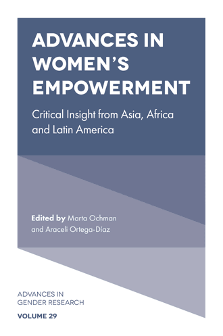
Index
Advances in Women’s Empowerment: Critical Insight from Asia, Africa and Latin America
ISBN: 978-1-83982-473-9, eISBN: 978-1-83982-472-2
ISSN: 1529-2126
Publication date: 21 September 2020
Citation
(2020), "Index", Ochman, M. and Ortega-Díaz, A. (Ed.) Advances in Women’s Empowerment: Critical Insight from Asia, Africa and Latin America (Advances in Gender Research, Vol. 29), Emerald Publishing Limited, Leeds, pp. 205-209. https://doi.org/10.1108/S1529-212620200000029013
Publisher
:Emerald Publishing Limited
Copyright © 2020 Emerald Publishing Limited
INDEX
Index
Note: Page numbers followed by “n” indicate end notes.
- Prelims
- Advances in Women’s Empowerment: An Overview
- Chapter 1: Recent Evidence on the Evolution of Women’s Empowerment Across Dimensions and Countries: A Multidimensional Index of Women’s Empowerment Across Countries
- Chapter 2: Empowerment and Desired Fertility in Sub Saharan Africa
- Chapter 3: Gender Differences in Intergenerational Income Mobility in Brazil
- Chapter 4: Urban Female Labor Force Participation and Its Correlates: A Comparative Study of Slum Dwellers and Their Urban Counterparts of Three Metro Cities in India
- Chapter 5: Marital Status and Poverty with Gender Bias
- Chapter 6: The Geography of Female Homicides and the Role of Civil Organizations in Mexico
- Chapter 7: Women’s Empowerment and Grassroots Organizations: An Argument for Bounded Empowerment
- Chapter 8: There Has Been No Silent Revolution: A Decade of Empowerment for Women in Rural Tamil Nadu
- Conclusions
- Index